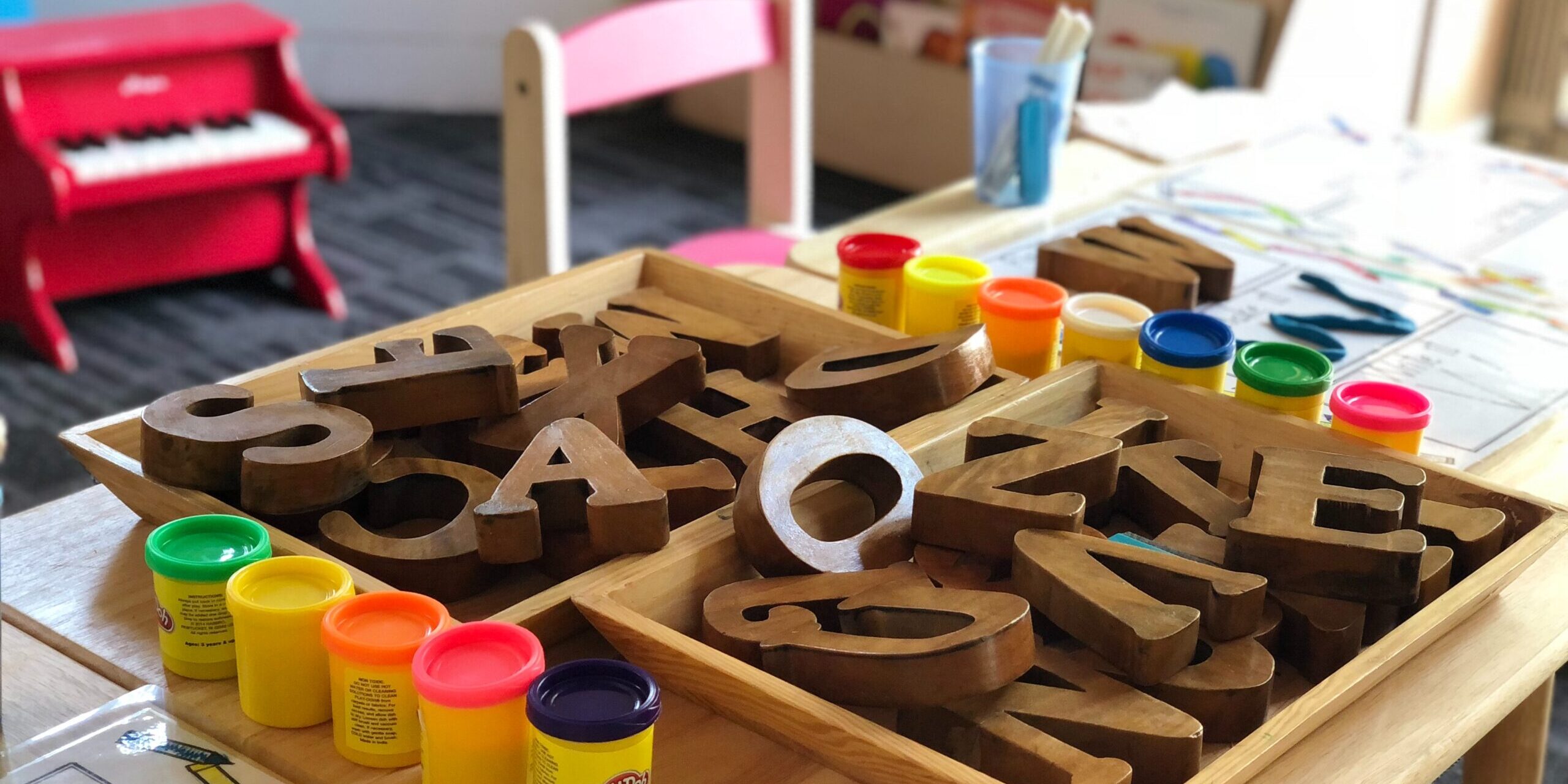Key Takeaways
- Tennessee has five categories of private schools — each with different accreditation and approval standards and requirements for curriculum, testing, and teacher qualifications.
- Lee proposes giving students about $7,100 per year for the costs and expenses of attending private school, which would be available to all 1.1 million of Tennessee’s school-aged children in the 2025-2026 school year.
- There are some similarities between the proposed Education Freedom Scholarships and the existing Education Savings Account program but also many key eligibility differences.
- Tennessee has 626 private schools in 76 counties and 95 school districts.
- In 2021-2022, about 960,000 Tennessee children — or 85% of all school-aged kids — were enrolled in public schools, but reliable data on where the remaining 165,000 were enrolled aren’t available.
Tennessee’s Education Freedom Scholarship Act will provide financial support to students attending private schools This report explains the program, highlights key features, and provides context and data on Tennessee’s private school landscape as of January 2024.
Note: This report was originally published on February 2, 2024. It was updated on February 19, 2025 to reflect the enacted version of the Education Freedom Scholarship Act.
The Sycamore Institute does not process applications for this program. For more information, visit www.tn.gov/education/efs.
Private School Types in Tennessee
Tennessee defines and categorizes several different types of public and nonpublic schools to inform compliance with state law requiring all children ages 6-17 to attend school (Figure 1). Public schools operate with public dollars overseen by a local school district or the state (i.e., traditional public schools) and those operating under a charter agreement with a local district or the state (i.e., public charter schools). Nonpublic schools include private schools that are either directly approved by the state or accredited/affiliated with an organization approved by the state. Home schools also meet the definition of nonpublic schools. (1) (2) (3)
Figure 1

Tennessee has five categories of private schools—each with different requirements for accreditation, approval, curriculum, testing, and teacher qualifications. Table 1 provides a high-level overview of the requirements associated with each category. Category I, II, and III schools are subject to the most requirements. Category IV church-related schools have fewer, and Category V schools are often in the process of meeting the requirements of one of the other categories. (6) (7)
Table 1
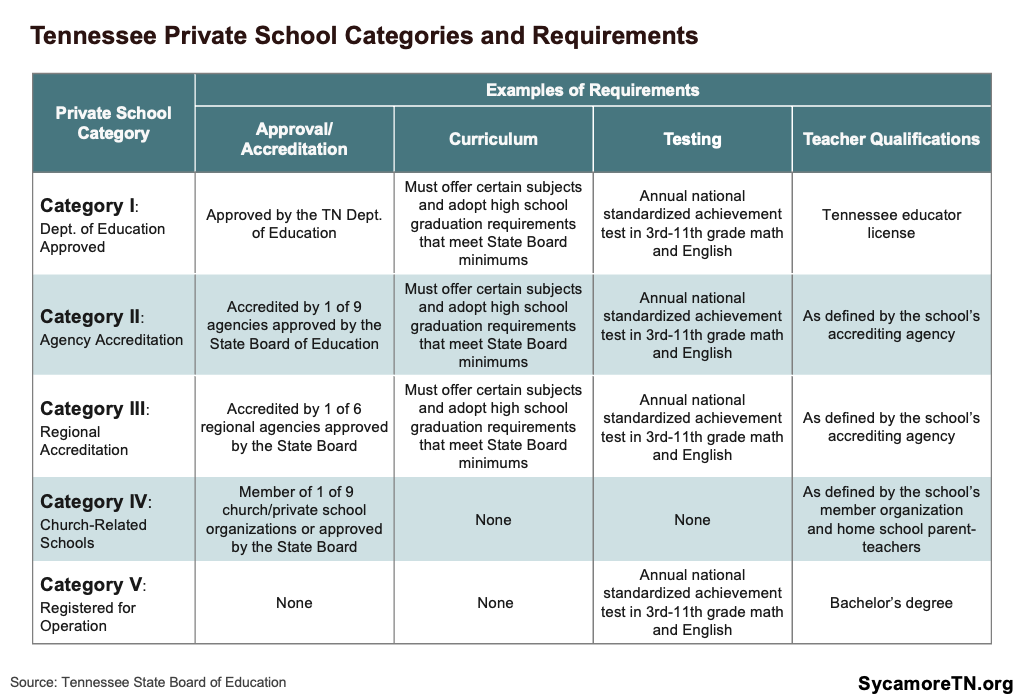
Home-schooled children can fit into more than one category of nonpublic schools. Independent home schools are those in which a parent or guardian is teaching their children. However, many home-schooled children may also be enrolled in Category III and IV private schools. Some Category III schools are accredited to provide online learning options, and Category IV includes many church-related umbrella schools, which offer various services to supplement home schooling. (4) (5)
Key Features of the Education Freedom Act
The Education Freedom Scholarship Act will provide Tennessee students about $7,300 per year for the costs and expenses of attending private school beginning in the 2025-2026 school year. The program will begin with 20,000 scholarships—which some refer to as vouchers. Annual growth in the number of available scholarships will depend on the prior year’s demand and funding. Half of the first year’s slots would be for students eligible for the state’s existing Education Saving Account (ESA) program (see text box), those under 300% of eligibility for reduced-price lunch, and applicants with disabilities. The remaining half would be available for any student. Additional details include: (8) (9) (10)
Number of Scholarships
- In the first year, 20,000 will be available for students attending Category I, II, or III private schools.
- If applications exceed 75% of available slots each year (i.e., more than 15,000 applicants in the 2025-2026 school year), the number the next year will increase by 5,000—subject to funding availability.
Scholarship Amount
- Each scholarship account would total $7,295 for the 2025-2026 school year. The amount would adjust automatically each year to equal the state portion of the base funding amount in the state’s school funding formula (i.e., the Tennessee Investment in Student Achievement—or TISA).
Covered Expenses
- Scholarship funds can pay for tuition and fees, textbooks, curricula, instruction materials, uniforms, tutoring services, transportation expenses, computer hardware, technological devices, other technology fees, summer school fees and materials, fees for postsecondary courses, exams, entrance exams, or industry certifications, and educational therapy services.
- Tuition and fee payments are prioritized, and remaining funds can pay for other eligible expenses.
- Unspent funds will roll over each year in a student’s account and remain available for eligible expenses until the student graduates from a private school, enrolls in a public K-12 school, voluntarily withdraws from the scholarship program, or is disqualified.
Student Eligibility
- Half of the first year’s scholarships would be for students eligible for the existing ESA program, those under 300% of eligibility for reduced-price lunch (i.e., about $173,000 for a family of 4 in the 2024-2025 school year(11)), and students with disabilities. The remaining half would be available for any student.
- In subsequent years, students already receiving an Education Freedom Scholarship will have priority, followed by new applicants under 100% of eligibility for reduced-price lunch (i.e., about $57,700 for a family of 4 in the 2024-2025 school year(11)), then 300% of eligibility for reduced-price lunch, public school students, incoming kindergarteners, and finally other applicants.
- Students receiving an Educational Freedom Scholarship cannot also receive funding under the ESA or Individualized Education Account programs.
School Eligibility
- Scholarships are limited to students enrolled only in Category I, II, and III private schools. The state’s existing ESA program is similarly limited to Category I, II, or III schools, but schools must apply to receive ESAs. As of January 2024, about 11% of the state’s private schools were approved to receive ESA funds (Figure 2). There is no similar application requirement for schools under the Education Freedom Scholarship Act.
Testing Requirements
- Each year, students in grades 3-11 with an Educational Freedom Scholarship must take the Tennessee Comprehensive Assessment Program (TCAP) or a nationally standardized achievement test.
Schools must submit scores to the Tennessee Comptroller’s Office of Research and Education Accountability (OREA), and OREA must submit an annual report of the results to the House and Senate Education Committees.
Figure 2
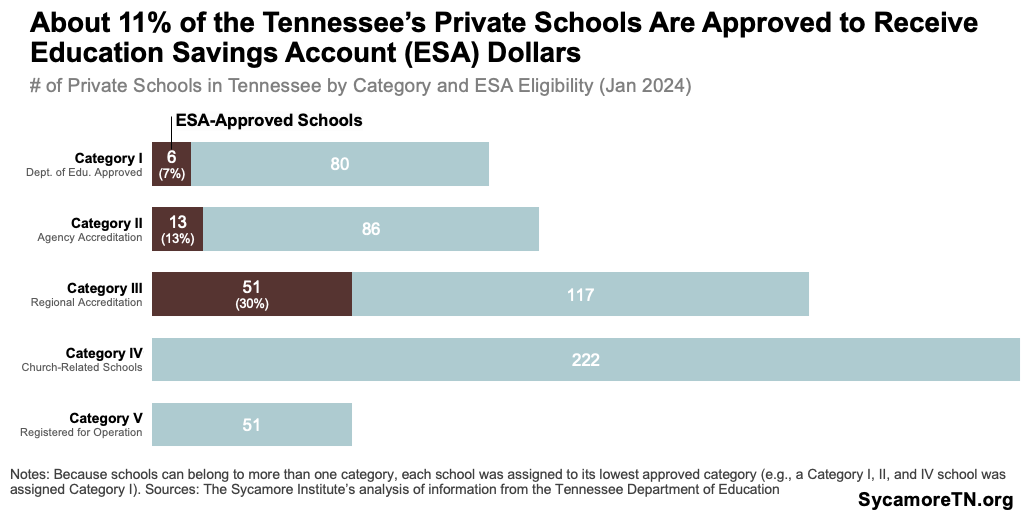
Education Savings Accounts
The Education Savings Account (ESA) program is separate from Education Freedom Scholarships. It was enacted in 2019 and first became available to students in the 2022-2023 school year. Tennessee also has a similar Individualized Education Account (IEA) program for students with disabilities. ESA eligibility is restricted to students whose family income meets certain guidelines and are zoned for one of four districts that meet specific school performance criteria. Family incomes are capped at twice the eligibility level for the free lunch program—which is about $82,000 for a family of 4 for the 2024-2025 school year. (11) ESA school district criteria translate to only three local education agencies—the Metro Nashville-Davidson County, Memphis-Shelby County School, and Hamilton County Districts. Students must also be previously enrolled or newly eligible to enroll in a Tennessee public school. (13) In the 2024-2025 school year, eligible students in Davidson and Shelby Counties were eligible to receive up to $9,070 and those in Hamilton up to $8,944. (14)
Figure 3
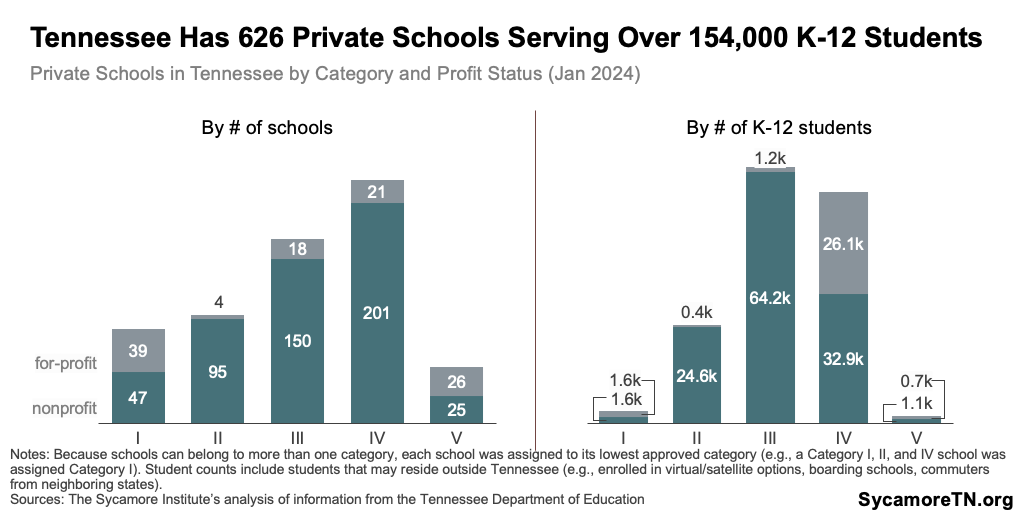
Tennessee’s Private School Landscape
Tennessee had 626 private schools in 76 counties (and 95 school districts) with over 154,000 K-12 students as of January 2024. These counts include an uncertain number of out-of-state students enrolled in virtual/satellite options, attending boarding schools, or commuting from other states. The rest of this report provides additional information on home and private schooling in Tennessee. Figures 3 and 4 provide statewide information on the number of private schools and students at those schools. Explore this information at the school district level using the Dashboard. Because schools can belong to multiple categories, we assigned each school to the lowest category to which it belongs (e.g., if a school belonged to Categories I, III, and IV, it was categorized as Category I). (12) (15)
The state comptroller’s office also offers two dashboards with more specific details on each private school and its enrollment. They are available here.
Figure 4
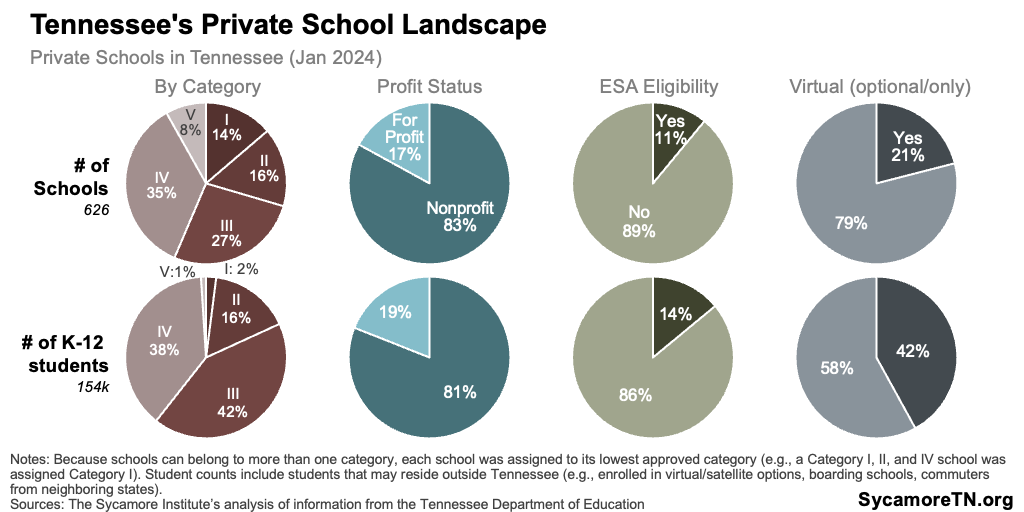
Use the interactive dashboard below to explore private schools in each school district.
Private and Home School Enrollment in Tennessee
In 2021-2022, about 960,000 Tennessee children — or 85% of all school-age kids — were enrolled in public schools, but reliable data on where the remaining 165,000 were enrolled aren’t available. (16) (17) (18) Here is what we do and don’t know about nonpublic school enrollment:
- The Tennessee private school data above includes counts of children from out-of-state and do not include children attending only independent home schools.
- In 2022, private or home schools enrolled as many as 172,000 Tennessee kids (or about 16%), according to Census Bureau estimates. That number exceeds other estimates and isn’t broken down by school category.(19)
- A study by the Urban Institute estimated that about 98,500 (or 9%) were enrolled in private schools in the Fall of 2021, and another 13,600 (or 1%) were in home schools. This study, however, could not account for almost 89,000 children (or 5%), and there is no information on how children who are primarily home-schooled but also enrolled in virtual/umbrella options were categorized.(18)
Although they may be imprecise, Census estimates provide a general picture of trends and geographic differences in nonpublic school enrollment in Tennessee. For example, the number and percentage of private and home school students in Tennessee have increased steadily since 2015 — with significant increases during the pandemic and a slight dip in 2022 (Figure 5). Across the state, these estimated proportions varied from a low of 1% in Clay County to a high of 38% in Pickett County for the 2018-2022 period (Figure 6). (20)
Figure 5
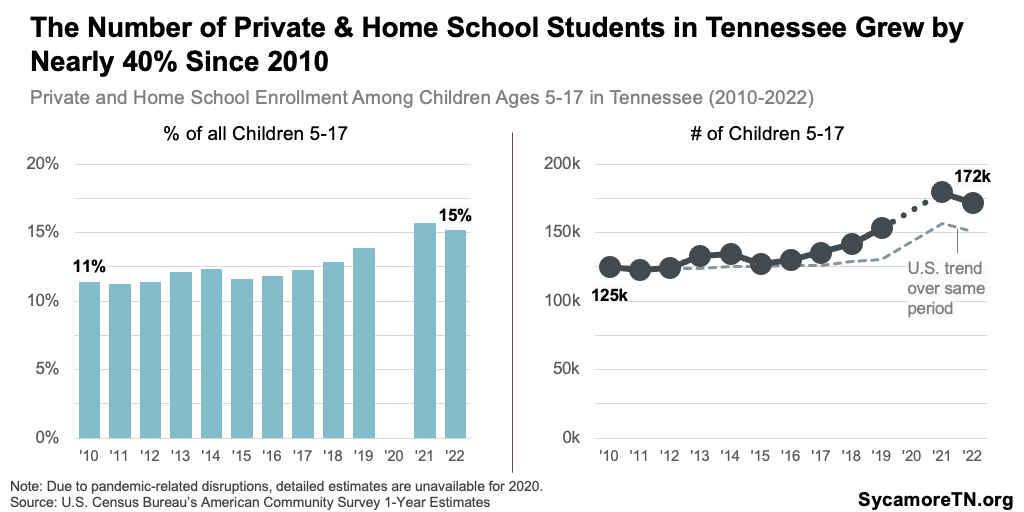
Figure 6
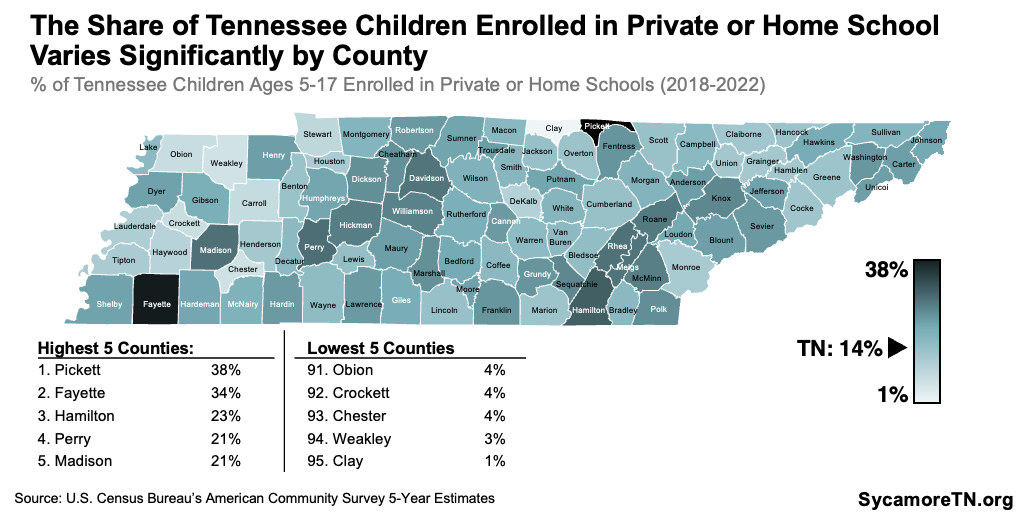
Explore the Data
Use the interactive map below for private school data by school district, nonprofit status, and school category.
References
Click to Open/Close
References
- State of Tennessee. Tenn. Code Ann. § 49-6-3001. Accessed via Lexis.
- Tennessee Department of Education. Education Choices in Tennessee. [Accessed on January 30, 2024.] https://www.tn.gov/education/families/school-options.html.
- State of Tennessee. Tenn. Code Ann. § 49-13-104. Accessed via Lexis.
- —. Tenn. Code Ann. § 49-6-3050. Accessed via Lexis.
- Tennessee Department of Education. Home School. [Accessed on January 26, 2024.] https://www.tn.gov/education/families/school-options/home-schooling-in-tn.html.
- Tennessee State Board of Education. Policy 3.500: Category II and III Private School Accrediting Agencies. February 10, 2023. https://www.tn.gov/content/dam/tn/stateboardofeducation/documents/2023-sbe-meetings/february-10%2c-2023-sbe-meeting/2-10-23%20IV%20K%20Category%20II%20and%20III%20Private%20Accrediting%20Agencies%20Policy%203.500%20Clean.pdf.
- —. Rule: Chapter 0520-07-02 Non-Public School Approval Process. August 2023. https://publications.tnsosfiles.com/rules/0520/0520-07/0520-07-02.20230815.pdf.
- Tennessee General Assembly. HB 6004 / SB 6001 (Education Freedom Scholarship Act). January 2025. https://www.capitol.tn.gov/Bills/114/Bill/HB6004.pdf.
- —. House Amendment 1 to HB 6004 / SB 6001. January 2025. https://www.capitol.tn.gov/Bills/114/Amend/HA6001.pdf.
- Fiscal Review Committee Staff. SB 6001 – HB 6004 Fiscal Memorandum. Tennessee General Assembly. January 28, 2025. https://www.capitol.tn.gov/Bills/114/Fiscal/FM0013.pdf.
- Tennessee Department of Education. ELIGIBILITY STANDARDS FOR FREE AND REDUCED-PRICE MEALS SY24-25. Free and Reduced-Price Meals . [Accessed on February 6, 2025.] https://www.tn.gov/education/districts/health-and-safety/school-nutrition/free-and-reduced-price-meals.html.
- —. Current List of Non-Public Schools. January 2, 2024. https://www.tn.gov/education/families/school-options/non-public-schools.html.
- —. ESA Program Eligibility Worksheet 2023-24. Cited: https://www.tn.gov/content/dam/tn/education/esa/ESA-Program-Eligibility-Worksheet-23-24_updated.pdf.
- —. Family Handbook: A Guide to the Education Savings Account (ESA) Program 2024-25 School Year. 2024. https://www.tn.gov/content/dam/tn/education/esa/ESA_2024-25_Family_Handbook.pdf.
- U.S. Census Bureau. SAIPE School District Estimates for 2022. December 2023. Accessed from https://www.census.gov/data/datasets/2022/demo/saipe/2022-school-districts.html.
- —. Annual Estimates of the Resident Population for Selected Age Groups by Sex: April 1, 2020 to July 1, 2022 (SC-EST2022-AGESEX). December 2023. https://www.census.gov/data/tables/time-series/demo/popest/2020s-state-detail.html.
- Tennessee Department of Education. 2022 Annual Statistical Report: Table 9 – 1st Month Membership. 2023. https://www.tn.gov/education/districts/federal-programs-and-oversight/data/department-reports/2022-annual-statistical-report.html.
- Dee, Thomas S. Where the Kids Went: Nonpublic Schooling and Demographic Change during the Pandemic Exodus from Public Schools. Urban Institute. February 2023. https://www.urban.org/sites/default/files/2023-02/Where%20the%20Kids%20Went-%20Nonpublic%20Schooling%20and%20Demographic%20Change%20during%20the%20Pandemic%20Exodus%20from%20Public%20Schools_0.pdf.
- U.S. Census Bureau. American Community Survey Questionnaire. https://www2.census.gov/programs-surveys/acs/methodology/questionnaires/2024/quest24GQ.pdf.
- —. American Community Survey 1- and 5-Year Estimates. Accessed via http://data.census.gov.

